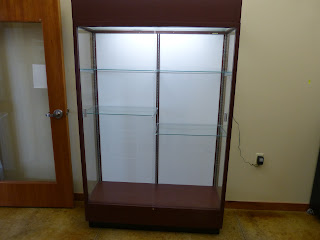Possibilities
It felt like Christmas all over again--powdery snow had recently added another layer to the Museum's blanketed yard, and a cheery man arrived early in the morning with a much-anticipated parcel in tow. I approached the cavernous semi-trailer as the delivery man maneuvered a pallet jack, and quickly beamed as I noticed the two new display cases positioned above me. Even though I paid considerably for them, I still consider the large cases to be a gift. I would now have a fresh opportunity to create any of the many collections displays I have recently dreamed up--and that surely feels like a gift to me.
At least a few times a day, I allow myself a short period of amusement as I search online for outside inspiration. Sometimes I might look for ways to provide opportunities for visitors to actually touch skulls, pelts, and other natural objects. At other times I try to figure out how various museums display their herbarium specimens. My habit of collecting ideas is part learning process, part creative inspiration. It's also part of why I love curation.
I find it particularly enjoyable to look at our entire collection and think of meaningful and interesting ways of sharing bits of that with the public. Perhaps I could introduce visitors to the disturbing yet intriguing side of fluid preserved mammals, or to the colorful array of local butterfly species. I might wish to expose them to our pressed plants, or tell a story of our first taxidermy specimens. In my eyes, an empty case still holds the promise of a new story before it's ever filled with objects.
 |
| "Under Renovation" is one of my favorite signs to install-- it means something new is underway! |
 |
| Even though these specimens left the case, they are still in the Museum! Some are still visible from the storage room. |
 |
| With specimens removed, the difficult task of removing glass panels was next. |
With new cases delivered only a few days later, I was relieved to see that most parts were already assembled. Still, I worked into the afternoon to remove hoards of plastic wrap and cardboard, and then wipe away an accumulation of dust and fingerprints before taking a deep breath and slumping into the bench behind my work area.
 |
| The Museum's new cases match three others we have. I look forward to a more consistent look throughout the building. |
What story will the contents of these new cases tell? Visitors to the Museum will have a chance to discover that momentarily, and I can't wait to share more next week.
